Case Study Analysis: Nursing Management of Diabetes in Geriatric Ward
VerifiedAdded on 2022/11/26
|14
|4224
|205
Case Study
AI Summary
This case study focuses on the nursing management of an 82-year-old male, Mr. George Brown, admitted to a geriatric ward with complications from type 2 diabetes. The assignment details his medical history, including foot ulcers, vision problems, and poor wound healing, and analyzes the pathophysiology of diabetes, diabetic retinopathy, and slow wound healing. It explores the roles of insulin resistance, beta-cell dysfunction, and vascular complications. The case study proposes a comprehensive management plan, including pharmacological interventions like metformin, lifestyle modifications, and patient education, to address high blood glucose levels, prevent further complications, and improve the patient's quality of life. The study emphasizes the importance of holistic care, addressing both physical and psychological needs, and promoting patient well-being within the context of a geriatric ward.
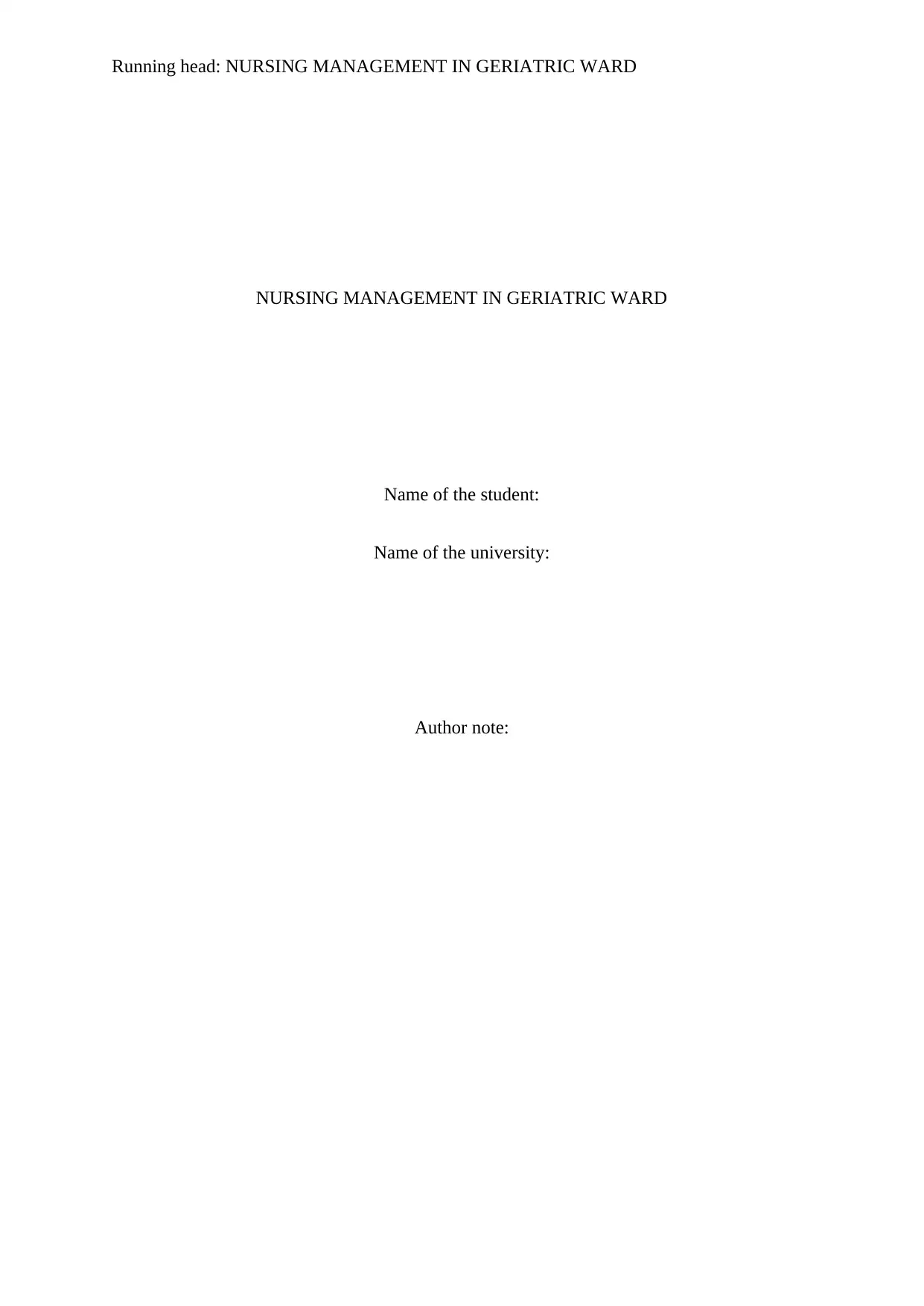
Running head: NURSING MANAGEMENT IN GERIATRIC WARD
NURSING MANAGEMENT IN GERIATRIC WARD
Name of the student:
Name of the university:
Author note:
NURSING MANAGEMENT IN GERIATRIC WARD
Name of the student:
Name of the university:
Author note:
Paraphrase This Document
Need a fresh take? Get an instant paraphrase of this document with our AI Paraphraser
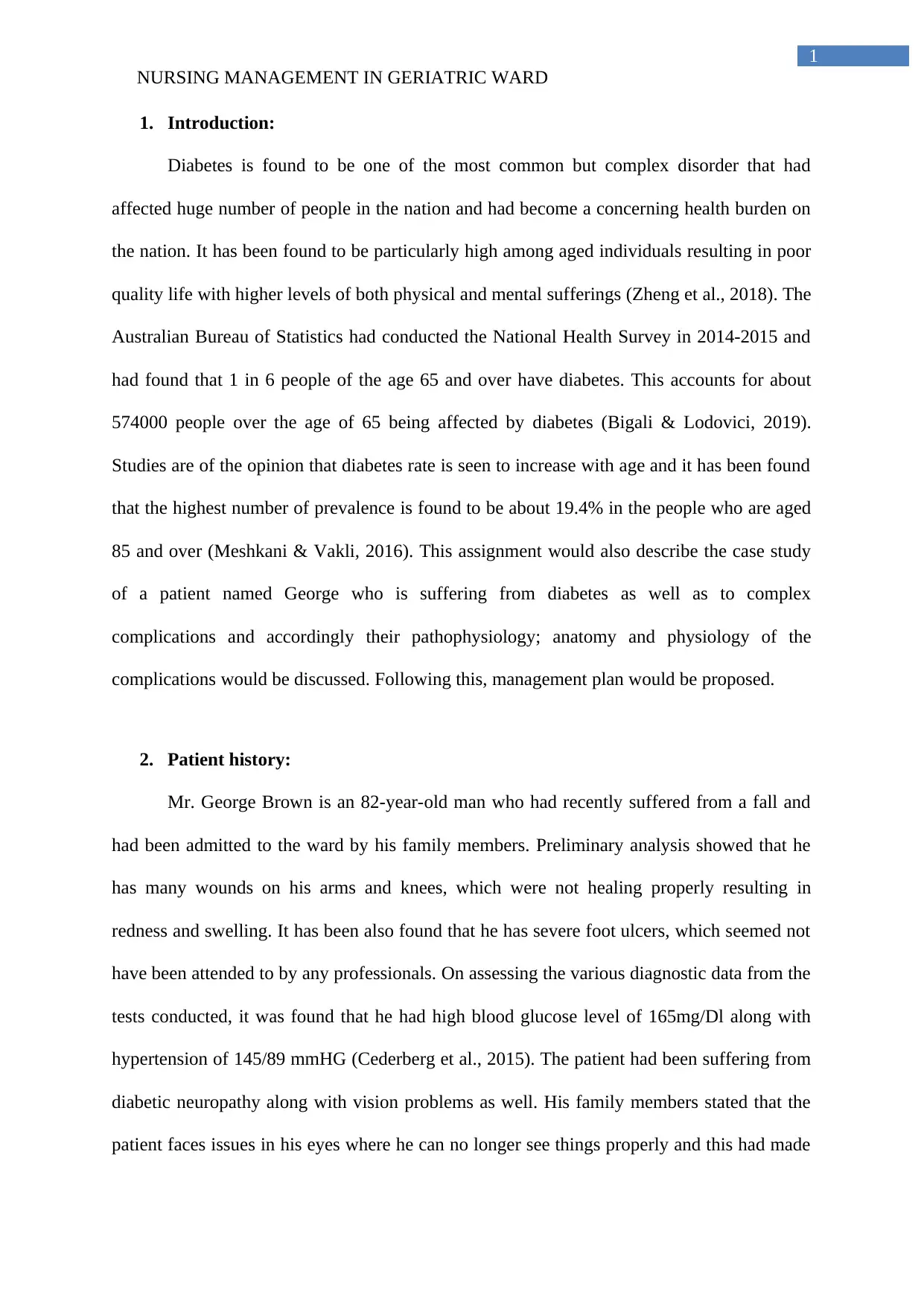
1
NURSING MANAGEMENT IN GERIATRIC WARD
1. Introduction:
Diabetes is found to be one of the most common but complex disorder that had
affected huge number of people in the nation and had become a concerning health burden on
the nation. It has been found to be particularly high among aged individuals resulting in poor
quality life with higher levels of both physical and mental sufferings (Zheng et al., 2018). The
Australian Bureau of Statistics had conducted the National Health Survey in 2014-2015 and
had found that 1 in 6 people of the age 65 and over have diabetes. This accounts for about
574000 people over the age of 65 being affected by diabetes (Bigali & Lodovici, 2019).
Studies are of the opinion that diabetes rate is seen to increase with age and it has been found
that the highest number of prevalence is found to be about 19.4% in the people who are aged
85 and over (Meshkani & Vakli, 2016). This assignment would also describe the case study
of a patient named George who is suffering from diabetes as well as to complex
complications and accordingly their pathophysiology; anatomy and physiology of the
complications would be discussed. Following this, management plan would be proposed.
2. Patient history:
Mr. George Brown is an 82-year-old man who had recently suffered from a fall and
had been admitted to the ward by his family members. Preliminary analysis showed that he
has many wounds on his arms and knees, which were not healing properly resulting in
redness and swelling. It has been also found that he has severe foot ulcers, which seemed not
have been attended to by any professionals. On assessing the various diagnostic data from the
tests conducted, it was found that he had high blood glucose level of 165mg/Dl along with
hypertension of 145/89 mmHG (Cederberg et al., 2015). The patient had been suffering from
diabetic neuropathy along with vision problems as well. His family members stated that the
patient faces issues in his eyes where he can no longer see things properly and this had made
NURSING MANAGEMENT IN GERIATRIC WARD
1. Introduction:
Diabetes is found to be one of the most common but complex disorder that had
affected huge number of people in the nation and had become a concerning health burden on
the nation. It has been found to be particularly high among aged individuals resulting in poor
quality life with higher levels of both physical and mental sufferings (Zheng et al., 2018). The
Australian Bureau of Statistics had conducted the National Health Survey in 2014-2015 and
had found that 1 in 6 people of the age 65 and over have diabetes. This accounts for about
574000 people over the age of 65 being affected by diabetes (Bigali & Lodovici, 2019).
Studies are of the opinion that diabetes rate is seen to increase with age and it has been found
that the highest number of prevalence is found to be about 19.4% in the people who are aged
85 and over (Meshkani & Vakli, 2016). This assignment would also describe the case study
of a patient named George who is suffering from diabetes as well as to complex
complications and accordingly their pathophysiology; anatomy and physiology of the
complications would be discussed. Following this, management plan would be proposed.
2. Patient history:
Mr. George Brown is an 82-year-old man who had recently suffered from a fall and
had been admitted to the ward by his family members. Preliminary analysis showed that he
has many wounds on his arms and knees, which were not healing properly resulting in
redness and swelling. It has been also found that he has severe foot ulcers, which seemed not
have been attended to by any professionals. On assessing the various diagnostic data from the
tests conducted, it was found that he had high blood glucose level of 165mg/Dl along with
hypertension of 145/89 mmHG (Cederberg et al., 2015). The patient had been suffering from
diabetic neuropathy along with vision problems as well. His family members stated that the
patient faces issues in his eyes where he can no longer see things properly and this had made
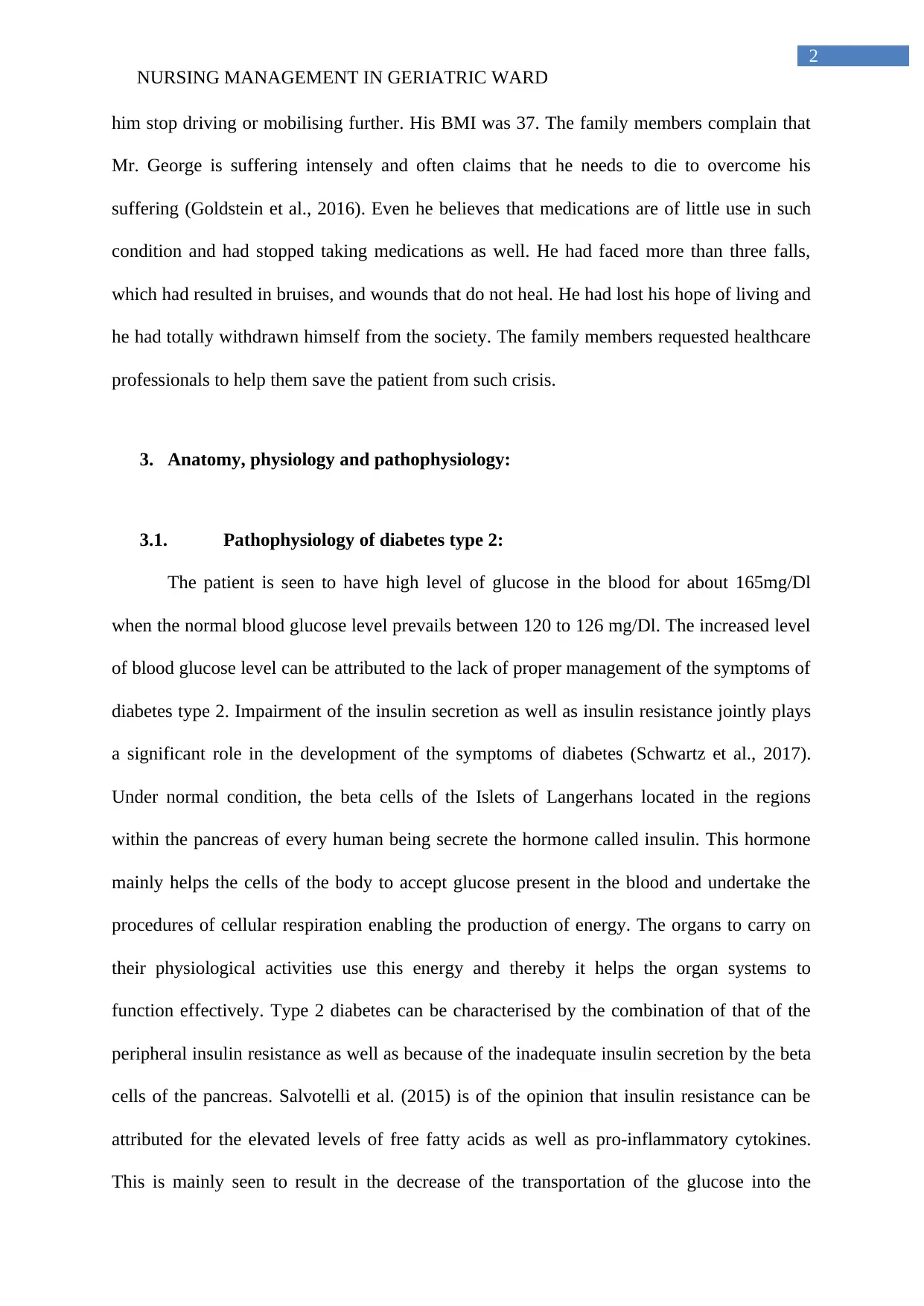
2
NURSING MANAGEMENT IN GERIATRIC WARD
him stop driving or mobilising further. His BMI was 37. The family members complain that
Mr. George is suffering intensely and often claims that he needs to die to overcome his
suffering (Goldstein et al., 2016). Even he believes that medications are of little use in such
condition and had stopped taking medications as well. He had faced more than three falls,
which had resulted in bruises, and wounds that do not heal. He had lost his hope of living and
he had totally withdrawn himself from the society. The family members requested healthcare
professionals to help them save the patient from such crisis.
3. Anatomy, physiology and pathophysiology:
3.1. Pathophysiology of diabetes type 2:
The patient is seen to have high level of glucose in the blood for about 165mg/Dl
when the normal blood glucose level prevails between 120 to 126 mg/Dl. The increased level
of blood glucose level can be attributed to the lack of proper management of the symptoms of
diabetes type 2. Impairment of the insulin secretion as well as insulin resistance jointly plays
a significant role in the development of the symptoms of diabetes (Schwartz et al., 2017).
Under normal condition, the beta cells of the Islets of Langerhans located in the regions
within the pancreas of every human being secrete the hormone called insulin. This hormone
mainly helps the cells of the body to accept glucose present in the blood and undertake the
procedures of cellular respiration enabling the production of energy. The organs to carry on
their physiological activities use this energy and thereby it helps the organ systems to
function effectively. Type 2 diabetes can be characterised by the combination of that of the
peripheral insulin resistance as well as because of the inadequate insulin secretion by the beta
cells of the pancreas. Salvotelli et al. (2015) is of the opinion that insulin resistance can be
attributed for the elevated levels of free fatty acids as well as pro-inflammatory cytokines.
This is mainly seen to result in the decrease of the transportation of the glucose into the
NURSING MANAGEMENT IN GERIATRIC WARD
him stop driving or mobilising further. His BMI was 37. The family members complain that
Mr. George is suffering intensely and often claims that he needs to die to overcome his
suffering (Goldstein et al., 2016). Even he believes that medications are of little use in such
condition and had stopped taking medications as well. He had faced more than three falls,
which had resulted in bruises, and wounds that do not heal. He had lost his hope of living and
he had totally withdrawn himself from the society. The family members requested healthcare
professionals to help them save the patient from such crisis.
3. Anatomy, physiology and pathophysiology:
3.1. Pathophysiology of diabetes type 2:
The patient is seen to have high level of glucose in the blood for about 165mg/Dl
when the normal blood glucose level prevails between 120 to 126 mg/Dl. The increased level
of blood glucose level can be attributed to the lack of proper management of the symptoms of
diabetes type 2. Impairment of the insulin secretion as well as insulin resistance jointly plays
a significant role in the development of the symptoms of diabetes (Schwartz et al., 2017).
Under normal condition, the beta cells of the Islets of Langerhans located in the regions
within the pancreas of every human being secrete the hormone called insulin. This hormone
mainly helps the cells of the body to accept glucose present in the blood and undertake the
procedures of cellular respiration enabling the production of energy. The organs to carry on
their physiological activities use this energy and thereby it helps the organ systems to
function effectively. Type 2 diabetes can be characterised by the combination of that of the
peripheral insulin resistance as well as because of the inadequate insulin secretion by the beta
cells of the pancreas. Salvotelli et al. (2015) is of the opinion that insulin resistance can be
attributed for the elevated levels of free fatty acids as well as pro-inflammatory cytokines.
This is mainly seen to result in the decrease of the transportation of the glucose into the
⊘ This is a preview!⊘
Do you want full access?
Subscribe today to unlock all pages.

Trusted by 1+ million students worldwide
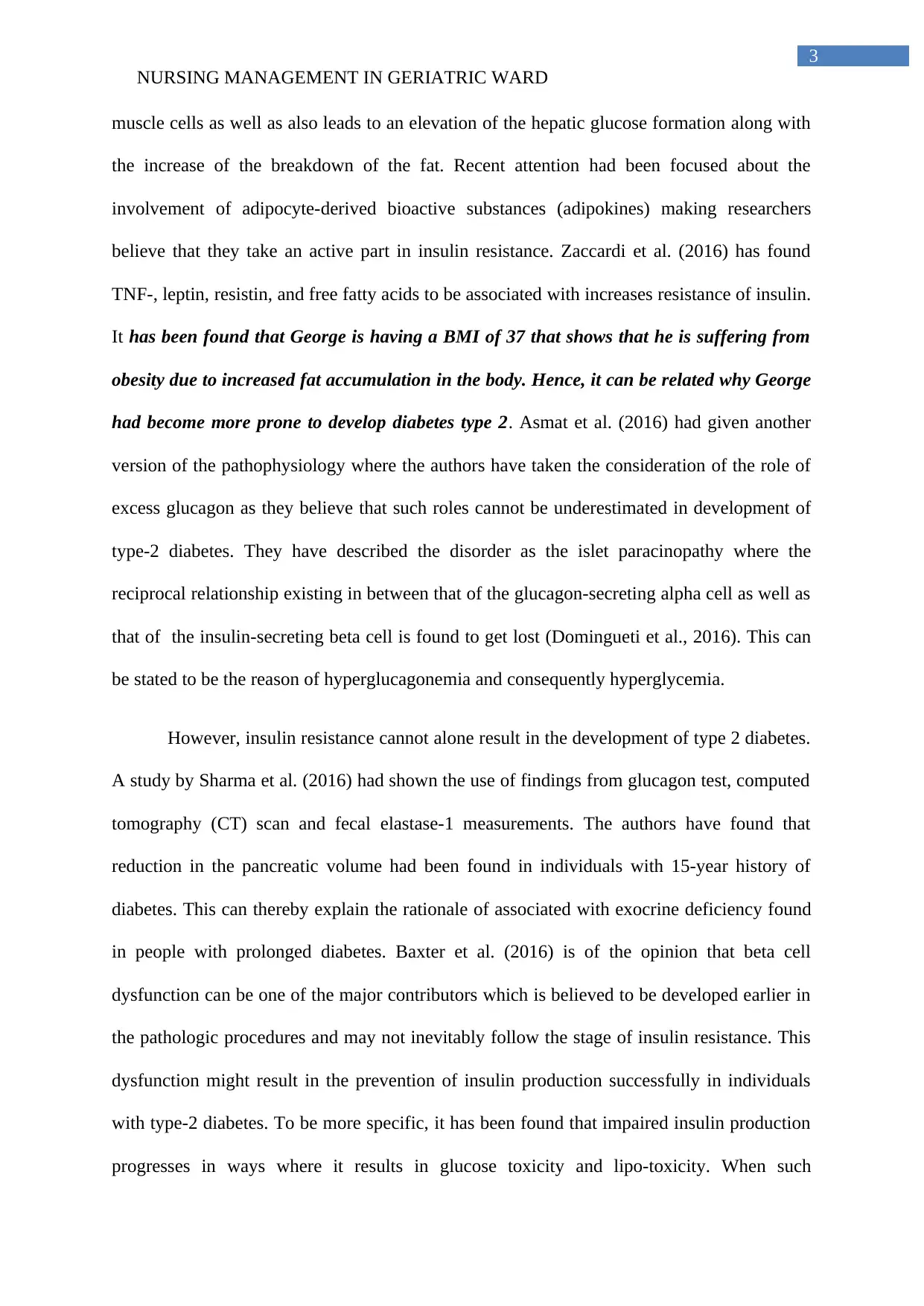
3
NURSING MANAGEMENT IN GERIATRIC WARD
muscle cells as well as also leads to an elevation of the hepatic glucose formation along with
the increase of the breakdown of the fat. Recent attention had been focused about the
involvement of adipocyte-derived bioactive substances (adipokines) making researchers
believe that they take an active part in insulin resistance. Zaccardi et al. (2016) has found
TNF-, leptin, resistin, and free fatty acids to be associated with increases resistance of insulin.
It has been found that George is having a BMI of 37 that shows that he is suffering from
obesity due to increased fat accumulation in the body. Hence, it can be related why George
had become more prone to develop diabetes type 2. Asmat et al. (2016) had given another
version of the pathophysiology where the authors have taken the consideration of the role of
excess glucagon as they believe that such roles cannot be underestimated in development of
type-2 diabetes. They have described the disorder as the islet paracinopathy where the
reciprocal relationship existing in between that of the glucagon-secreting alpha cell as well as
that of the insulin-secreting beta cell is found to get lost (Domingueti et al., 2016). This can
be stated to be the reason of hyperglucagonemia and consequently hyperglycemia.
However, insulin resistance cannot alone result in the development of type 2 diabetes.
A study by Sharma et al. (2016) had shown the use of findings from glucagon test, computed
tomography (CT) scan and fecal elastase-1 measurements. The authors have found that
reduction in the pancreatic volume had been found in individuals with 15-year history of
diabetes. This can thereby explain the rationale of associated with exocrine deficiency found
in people with prolonged diabetes. Baxter et al. (2016) is of the opinion that beta cell
dysfunction can be one of the major contributors which is believed to be developed earlier in
the pathologic procedures and may not inevitably follow the stage of insulin resistance. This
dysfunction might result in the prevention of insulin production successfully in individuals
with type-2 diabetes. To be more specific, it has been found that impaired insulin production
progresses in ways where it results in glucose toxicity and lipo-toxicity. When such
NURSING MANAGEMENT IN GERIATRIC WARD
muscle cells as well as also leads to an elevation of the hepatic glucose formation along with
the increase of the breakdown of the fat. Recent attention had been focused about the
involvement of adipocyte-derived bioactive substances (adipokines) making researchers
believe that they take an active part in insulin resistance. Zaccardi et al. (2016) has found
TNF-, leptin, resistin, and free fatty acids to be associated with increases resistance of insulin.
It has been found that George is having a BMI of 37 that shows that he is suffering from
obesity due to increased fat accumulation in the body. Hence, it can be related why George
had become more prone to develop diabetes type 2. Asmat et al. (2016) had given another
version of the pathophysiology where the authors have taken the consideration of the role of
excess glucagon as they believe that such roles cannot be underestimated in development of
type-2 diabetes. They have described the disorder as the islet paracinopathy where the
reciprocal relationship existing in between that of the glucagon-secreting alpha cell as well as
that of the insulin-secreting beta cell is found to get lost (Domingueti et al., 2016). This can
be stated to be the reason of hyperglucagonemia and consequently hyperglycemia.
However, insulin resistance cannot alone result in the development of type 2 diabetes.
A study by Sharma et al. (2016) had shown the use of findings from glucagon test, computed
tomography (CT) scan and fecal elastase-1 measurements. The authors have found that
reduction in the pancreatic volume had been found in individuals with 15-year history of
diabetes. This can thereby explain the rationale of associated with exocrine deficiency found
in people with prolonged diabetes. Baxter et al. (2016) is of the opinion that beta cell
dysfunction can be one of the major contributors which is believed to be developed earlier in
the pathologic procedures and may not inevitably follow the stage of insulin resistance. This
dysfunction might result in the prevention of insulin production successfully in individuals
with type-2 diabetes. To be more specific, it has been found that impaired insulin production
progresses in ways where it results in glucose toxicity and lipo-toxicity. When such
Paraphrase This Document
Need a fresh take? Get an instant paraphrase of this document with our AI Paraphraser
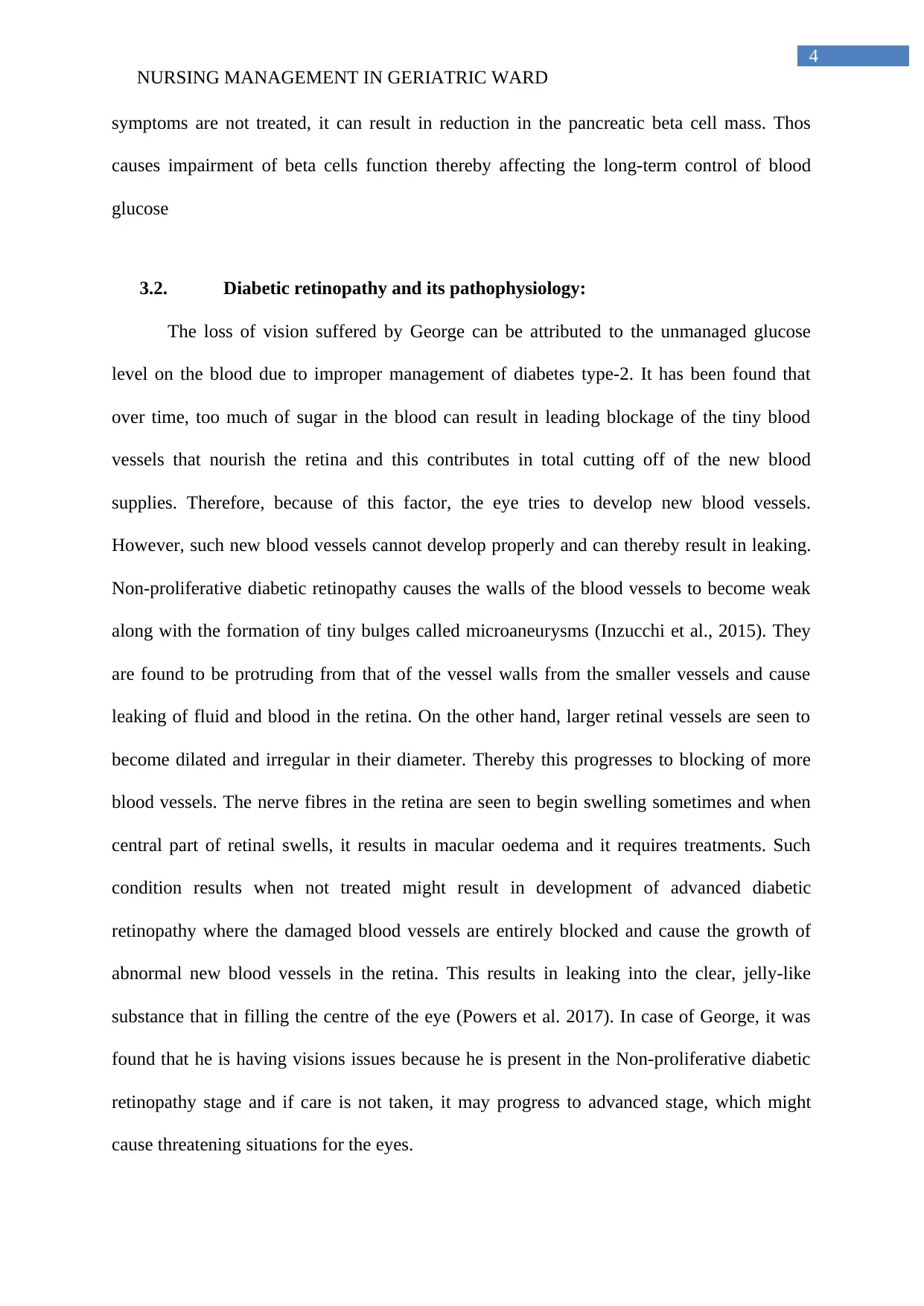
4
NURSING MANAGEMENT IN GERIATRIC WARD
symptoms are not treated, it can result in reduction in the pancreatic beta cell mass. Thos
causes impairment of beta cells function thereby affecting the long-term control of blood
glucose
3.2. Diabetic retinopathy and its pathophysiology:
The loss of vision suffered by George can be attributed to the unmanaged glucose
level on the blood due to improper management of diabetes type-2. It has been found that
over time, too much of sugar in the blood can result in leading blockage of the tiny blood
vessels that nourish the retina and this contributes in total cutting off of the new blood
supplies. Therefore, because of this factor, the eye tries to develop new blood vessels.
However, such new blood vessels cannot develop properly and can thereby result in leaking.
Non-proliferative diabetic retinopathy causes the walls of the blood vessels to become weak
along with the formation of tiny bulges called microaneurysms (Inzucchi et al., 2015). They
are found to be protruding from that of the vessel walls from the smaller vessels and cause
leaking of fluid and blood in the retina. On the other hand, larger retinal vessels are seen to
become dilated and irregular in their diameter. Thereby this progresses to blocking of more
blood vessels. The nerve fibres in the retina are seen to begin swelling sometimes and when
central part of retinal swells, it results in macular oedema and it requires treatments. Such
condition results when not treated might result in development of advanced diabetic
retinopathy where the damaged blood vessels are entirely blocked and cause the growth of
abnormal new blood vessels in the retina. This results in leaking into the clear, jelly-like
substance that in filling the centre of the eye (Powers et al. 2017). In case of George, it was
found that he is having visions issues because he is present in the Non-proliferative diabetic
retinopathy stage and if care is not taken, it may progress to advanced stage, which might
cause threatening situations for the eyes.
NURSING MANAGEMENT IN GERIATRIC WARD
symptoms are not treated, it can result in reduction in the pancreatic beta cell mass. Thos
causes impairment of beta cells function thereby affecting the long-term control of blood
glucose
3.2. Diabetic retinopathy and its pathophysiology:
The loss of vision suffered by George can be attributed to the unmanaged glucose
level on the blood due to improper management of diabetes type-2. It has been found that
over time, too much of sugar in the blood can result in leading blockage of the tiny blood
vessels that nourish the retina and this contributes in total cutting off of the new blood
supplies. Therefore, because of this factor, the eye tries to develop new blood vessels.
However, such new blood vessels cannot develop properly and can thereby result in leaking.
Non-proliferative diabetic retinopathy causes the walls of the blood vessels to become weak
along with the formation of tiny bulges called microaneurysms (Inzucchi et al., 2015). They
are found to be protruding from that of the vessel walls from the smaller vessels and cause
leaking of fluid and blood in the retina. On the other hand, larger retinal vessels are seen to
become dilated and irregular in their diameter. Thereby this progresses to blocking of more
blood vessels. The nerve fibres in the retina are seen to begin swelling sometimes and when
central part of retinal swells, it results in macular oedema and it requires treatments. Such
condition results when not treated might result in development of advanced diabetic
retinopathy where the damaged blood vessels are entirely blocked and cause the growth of
abnormal new blood vessels in the retina. This results in leaking into the clear, jelly-like
substance that in filling the centre of the eye (Powers et al. 2017). In case of George, it was
found that he is having visions issues because he is present in the Non-proliferative diabetic
retinopathy stage and if care is not taken, it may progress to advanced stage, which might
cause threatening situations for the eyes.
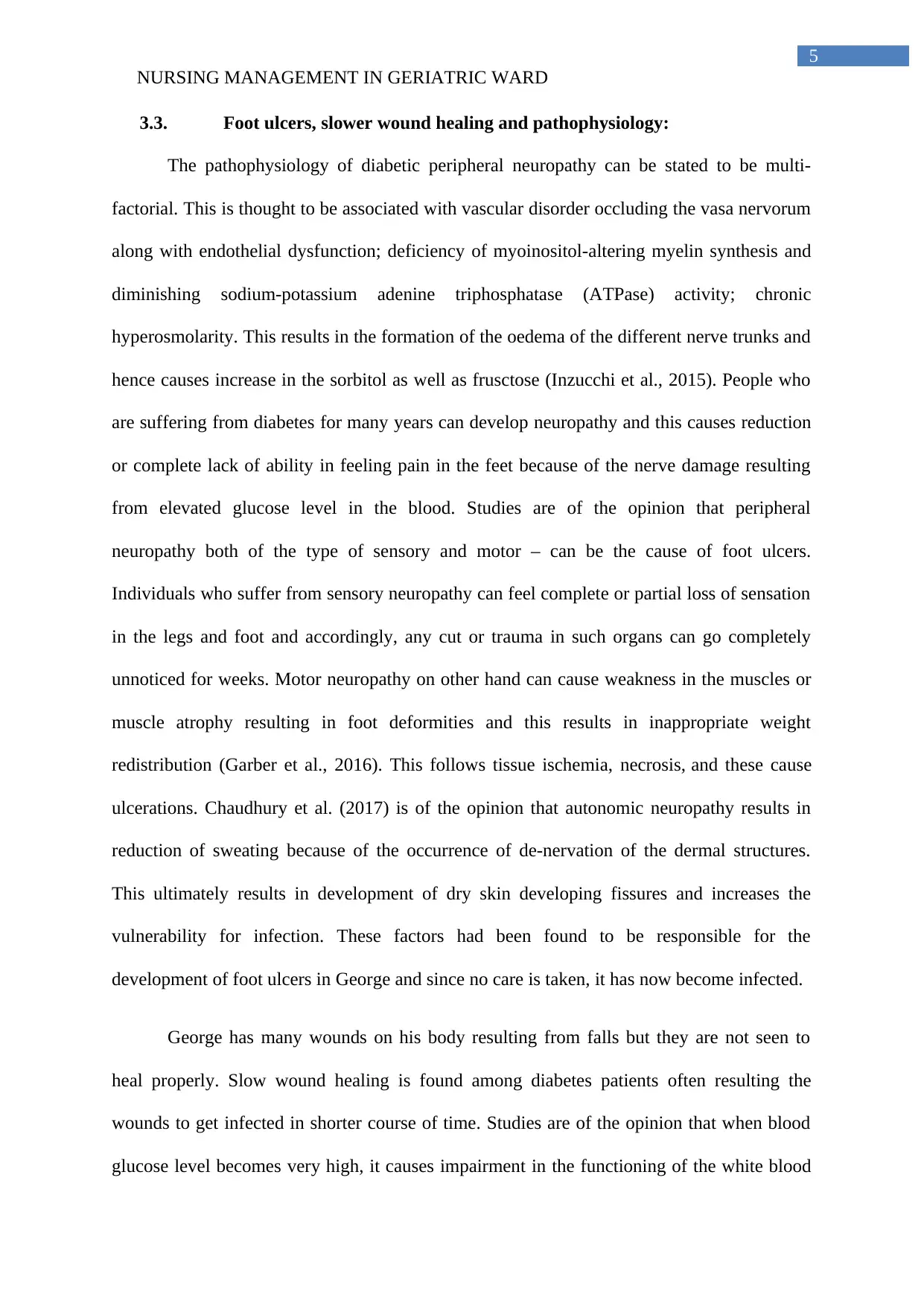
5
NURSING MANAGEMENT IN GERIATRIC WARD
3.3. Foot ulcers, slower wound healing and pathophysiology:
The pathophysiology of diabetic peripheral neuropathy can be stated to be multi-
factorial. This is thought to be associated with vascular disorder occluding the vasa nervorum
along with endothelial dysfunction; deficiency of myoinositol-altering myelin synthesis and
diminishing sodium-potassium adenine triphosphatase (ATPase) activity; chronic
hyperosmolarity. This results in the formation of the oedema of the different nerve trunks and
hence causes increase in the sorbitol as well as frusctose (Inzucchi et al., 2015). People who
are suffering from diabetes for many years can develop neuropathy and this causes reduction
or complete lack of ability in feeling pain in the feet because of the nerve damage resulting
from elevated glucose level in the blood. Studies are of the opinion that peripheral
neuropathy both of the type of sensory and motor – can be the cause of foot ulcers.
Individuals who suffer from sensory neuropathy can feel complete or partial loss of sensation
in the legs and foot and accordingly, any cut or trauma in such organs can go completely
unnoticed for weeks. Motor neuropathy on other hand can cause weakness in the muscles or
muscle atrophy resulting in foot deformities and this results in inappropriate weight
redistribution (Garber et al., 2016). This follows tissue ischemia, necrosis, and these cause
ulcerations. Chaudhury et al. (2017) is of the opinion that autonomic neuropathy results in
reduction of sweating because of the occurrence of de-nervation of the dermal structures.
This ultimately results in development of dry skin developing fissures and increases the
vulnerability for infection. These factors had been found to be responsible for the
development of foot ulcers in George and since no care is taken, it has now become infected.
George has many wounds on his body resulting from falls but they are not seen to
heal properly. Slow wound healing is found among diabetes patients often resulting the
wounds to get infected in shorter course of time. Studies are of the opinion that when blood
glucose level becomes very high, it causes impairment in the functioning of the white blood
NURSING MANAGEMENT IN GERIATRIC WARD
3.3. Foot ulcers, slower wound healing and pathophysiology:
The pathophysiology of diabetic peripheral neuropathy can be stated to be multi-
factorial. This is thought to be associated with vascular disorder occluding the vasa nervorum
along with endothelial dysfunction; deficiency of myoinositol-altering myelin synthesis and
diminishing sodium-potassium adenine triphosphatase (ATPase) activity; chronic
hyperosmolarity. This results in the formation of the oedema of the different nerve trunks and
hence causes increase in the sorbitol as well as frusctose (Inzucchi et al., 2015). People who
are suffering from diabetes for many years can develop neuropathy and this causes reduction
or complete lack of ability in feeling pain in the feet because of the nerve damage resulting
from elevated glucose level in the blood. Studies are of the opinion that peripheral
neuropathy both of the type of sensory and motor – can be the cause of foot ulcers.
Individuals who suffer from sensory neuropathy can feel complete or partial loss of sensation
in the legs and foot and accordingly, any cut or trauma in such organs can go completely
unnoticed for weeks. Motor neuropathy on other hand can cause weakness in the muscles or
muscle atrophy resulting in foot deformities and this results in inappropriate weight
redistribution (Garber et al., 2016). This follows tissue ischemia, necrosis, and these cause
ulcerations. Chaudhury et al. (2017) is of the opinion that autonomic neuropathy results in
reduction of sweating because of the occurrence of de-nervation of the dermal structures.
This ultimately results in development of dry skin developing fissures and increases the
vulnerability for infection. These factors had been found to be responsible for the
development of foot ulcers in George and since no care is taken, it has now become infected.
George has many wounds on his body resulting from falls but they are not seen to
heal properly. Slow wound healing is found among diabetes patients often resulting the
wounds to get infected in shorter course of time. Studies are of the opinion that when blood
glucose level becomes very high, it causes impairment in the functioning of the white blood
⊘ This is a preview!⊘
Do you want full access?
Subscribe today to unlock all pages.

Trusted by 1+ million students worldwide
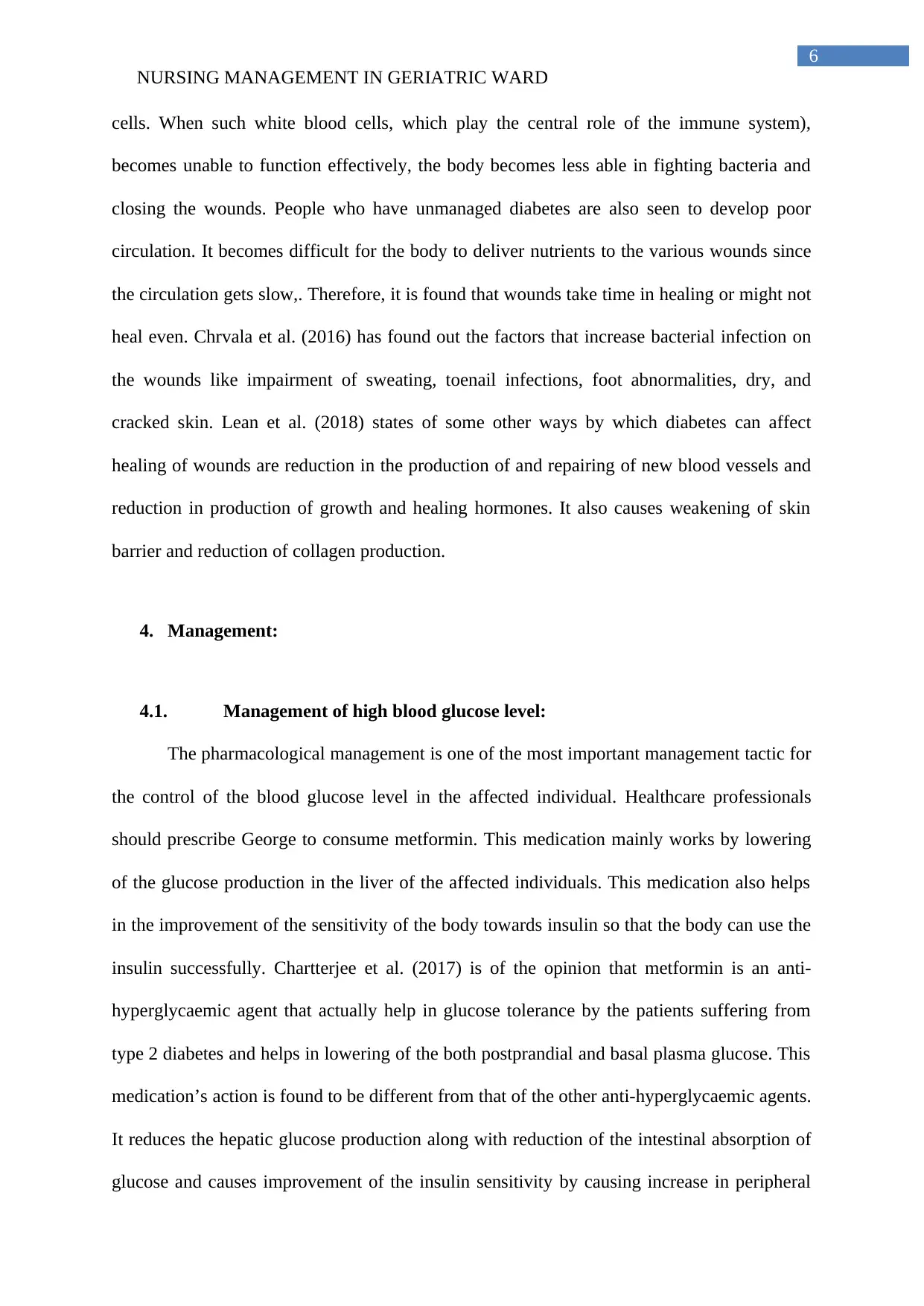
6
NURSING MANAGEMENT IN GERIATRIC WARD
cells. When such white blood cells, which play the central role of the immune system),
becomes unable to function effectively, the body becomes less able in fighting bacteria and
closing the wounds. People who have unmanaged diabetes are also seen to develop poor
circulation. It becomes difficult for the body to deliver nutrients to the various wounds since
the circulation gets slow,. Therefore, it is found that wounds take time in healing or might not
heal even. Chrvala et al. (2016) has found out the factors that increase bacterial infection on
the wounds like impairment of sweating, toenail infections, foot abnormalities, dry, and
cracked skin. Lean et al. (2018) states of some other ways by which diabetes can affect
healing of wounds are reduction in the production of and repairing of new blood vessels and
reduction in production of growth and healing hormones. It also causes weakening of skin
barrier and reduction of collagen production.
4. Management:
4.1. Management of high blood glucose level:
The pharmacological management is one of the most important management tactic for
the control of the blood glucose level in the affected individual. Healthcare professionals
should prescribe George to consume metformin. This medication mainly works by lowering
of the glucose production in the liver of the affected individuals. This medication also helps
in the improvement of the sensitivity of the body towards insulin so that the body can use the
insulin successfully. Chartterjee et al. (2017) is of the opinion that metformin is an anti-
hyperglycaemic agent that actually help in glucose tolerance by the patients suffering from
type 2 diabetes and helps in lowering of the both postprandial and basal plasma glucose. This
medication’s action is found to be different from that of the other anti-hyperglycaemic agents.
It reduces the hepatic glucose production along with reduction of the intestinal absorption of
glucose and causes improvement of the insulin sensitivity by causing increase in peripheral
NURSING MANAGEMENT IN GERIATRIC WARD
cells. When such white blood cells, which play the central role of the immune system),
becomes unable to function effectively, the body becomes less able in fighting bacteria and
closing the wounds. People who have unmanaged diabetes are also seen to develop poor
circulation. It becomes difficult for the body to deliver nutrients to the various wounds since
the circulation gets slow,. Therefore, it is found that wounds take time in healing or might not
heal even. Chrvala et al. (2016) has found out the factors that increase bacterial infection on
the wounds like impairment of sweating, toenail infections, foot abnormalities, dry, and
cracked skin. Lean et al. (2018) states of some other ways by which diabetes can affect
healing of wounds are reduction in the production of and repairing of new blood vessels and
reduction in production of growth and healing hormones. It also causes weakening of skin
barrier and reduction of collagen production.
4. Management:
4.1. Management of high blood glucose level:
The pharmacological management is one of the most important management tactic for
the control of the blood glucose level in the affected individual. Healthcare professionals
should prescribe George to consume metformin. This medication mainly works by lowering
of the glucose production in the liver of the affected individuals. This medication also helps
in the improvement of the sensitivity of the body towards insulin so that the body can use the
insulin successfully. Chartterjee et al. (2017) is of the opinion that metformin is an anti-
hyperglycaemic agent that actually help in glucose tolerance by the patients suffering from
type 2 diabetes and helps in lowering of the both postprandial and basal plasma glucose. This
medication’s action is found to be different from that of the other anti-hyperglycaemic agents.
It reduces the hepatic glucose production along with reduction of the intestinal absorption of
glucose and causes improvement of the insulin sensitivity by causing increase in peripheral
Paraphrase This Document
Need a fresh take? Get an instant paraphrase of this document with our AI Paraphraser
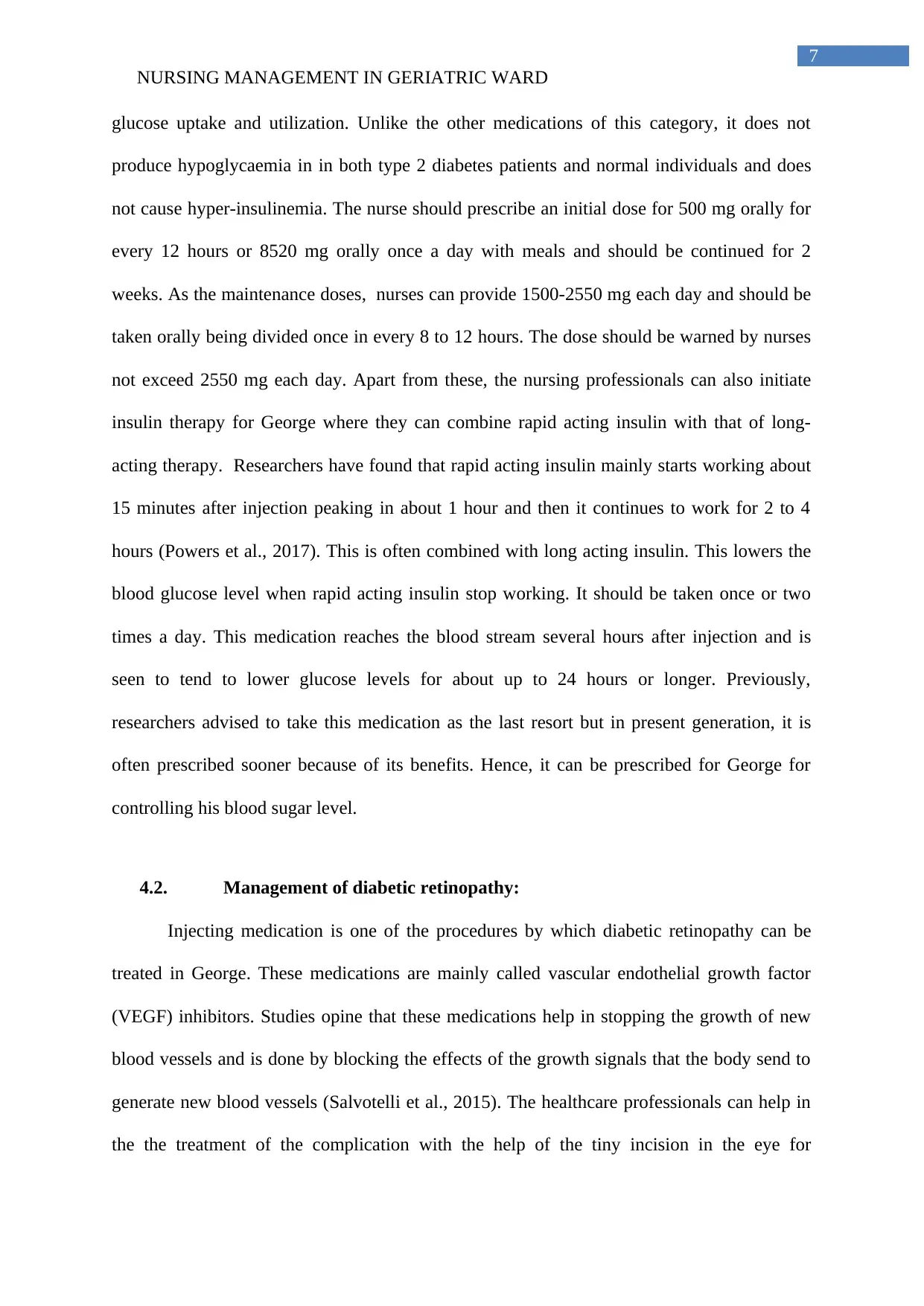
7
NURSING MANAGEMENT IN GERIATRIC WARD
glucose uptake and utilization. Unlike the other medications of this category, it does not
produce hypoglycaemia in in both type 2 diabetes patients and normal individuals and does
not cause hyper-insulinemia. The nurse should prescribe an initial dose for 500 mg orally for
every 12 hours or 8520 mg orally once a day with meals and should be continued for 2
weeks. As the maintenance doses, nurses can provide 1500-2550 mg each day and should be
taken orally being divided once in every 8 to 12 hours. The dose should be warned by nurses
not exceed 2550 mg each day. Apart from these, the nursing professionals can also initiate
insulin therapy for George where they can combine rapid acting insulin with that of long-
acting therapy. Researchers have found that rapid acting insulin mainly starts working about
15 minutes after injection peaking in about 1 hour and then it continues to work for 2 to 4
hours (Powers et al., 2017). This is often combined with long acting insulin. This lowers the
blood glucose level when rapid acting insulin stop working. It should be taken once or two
times a day. This medication reaches the blood stream several hours after injection and is
seen to tend to lower glucose levels for about up to 24 hours or longer. Previously,
researchers advised to take this medication as the last resort but in present generation, it is
often prescribed sooner because of its benefits. Hence, it can be prescribed for George for
controlling his blood sugar level.
4.2. Management of diabetic retinopathy:
Injecting medication is one of the procedures by which diabetic retinopathy can be
treated in George. These medications are mainly called vascular endothelial growth factor
(VEGF) inhibitors. Studies opine that these medications help in stopping the growth of new
blood vessels and is done by blocking the effects of the growth signals that the body send to
generate new blood vessels (Salvotelli et al., 2015). The healthcare professionals can help in
the the treatment of the complication with the help of the tiny incision in the eye for
NURSING MANAGEMENT IN GERIATRIC WARD
glucose uptake and utilization. Unlike the other medications of this category, it does not
produce hypoglycaemia in in both type 2 diabetes patients and normal individuals and does
not cause hyper-insulinemia. The nurse should prescribe an initial dose for 500 mg orally for
every 12 hours or 8520 mg orally once a day with meals and should be continued for 2
weeks. As the maintenance doses, nurses can provide 1500-2550 mg each day and should be
taken orally being divided once in every 8 to 12 hours. The dose should be warned by nurses
not exceed 2550 mg each day. Apart from these, the nursing professionals can also initiate
insulin therapy for George where they can combine rapid acting insulin with that of long-
acting therapy. Researchers have found that rapid acting insulin mainly starts working about
15 minutes after injection peaking in about 1 hour and then it continues to work for 2 to 4
hours (Powers et al., 2017). This is often combined with long acting insulin. This lowers the
blood glucose level when rapid acting insulin stop working. It should be taken once or two
times a day. This medication reaches the blood stream several hours after injection and is
seen to tend to lower glucose levels for about up to 24 hours or longer. Previously,
researchers advised to take this medication as the last resort but in present generation, it is
often prescribed sooner because of its benefits. Hence, it can be prescribed for George for
controlling his blood sugar level.
4.2. Management of diabetic retinopathy:
Injecting medication is one of the procedures by which diabetic retinopathy can be
treated in George. These medications are mainly called vascular endothelial growth factor
(VEGF) inhibitors. Studies opine that these medications help in stopping the growth of new
blood vessels and is done by blocking the effects of the growth signals that the body send to
generate new blood vessels (Salvotelli et al., 2015). The healthcare professionals can help in
the the treatment of the complication with the help of the tiny incision in the eye for
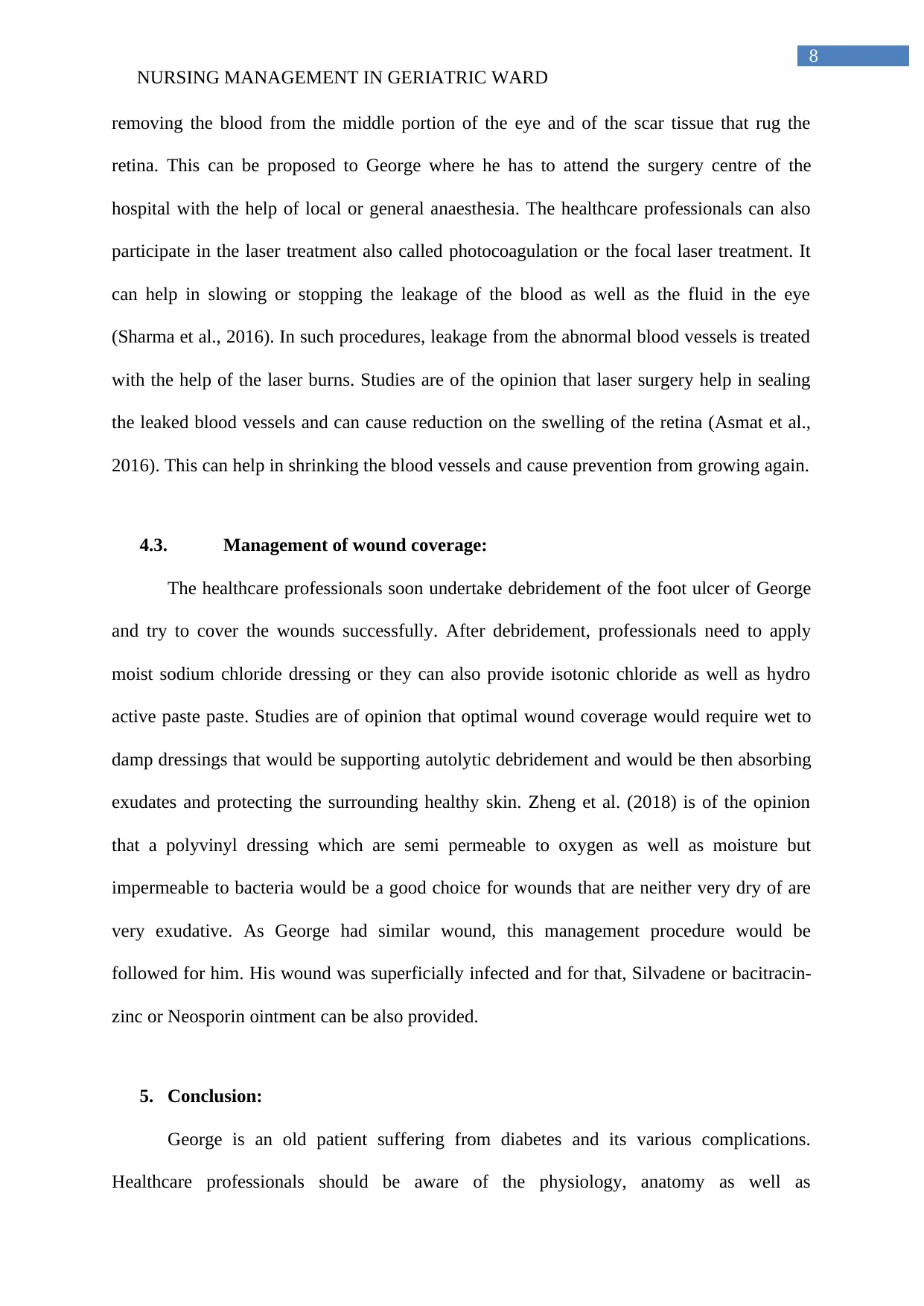
8
NURSING MANAGEMENT IN GERIATRIC WARD
removing the blood from the middle portion of the eye and of the scar tissue that rug the
retina. This can be proposed to George where he has to attend the surgery centre of the
hospital with the help of local or general anaesthesia. The healthcare professionals can also
participate in the laser treatment also called photocoagulation or the focal laser treatment. It
can help in slowing or stopping the leakage of the blood as well as the fluid in the eye
(Sharma et al., 2016). In such procedures, leakage from the abnormal blood vessels is treated
with the help of the laser burns. Studies are of the opinion that laser surgery help in sealing
the leaked blood vessels and can cause reduction on the swelling of the retina (Asmat et al.,
2016). This can help in shrinking the blood vessels and cause prevention from growing again.
4.3. Management of wound coverage:
The healthcare professionals soon undertake debridement of the foot ulcer of George
and try to cover the wounds successfully. After debridement, professionals need to apply
moist sodium chloride dressing or they can also provide isotonic chloride as well as hydro
active paste paste. Studies are of opinion that optimal wound coverage would require wet to
damp dressings that would be supporting autolytic debridement and would be then absorbing
exudates and protecting the surrounding healthy skin. Zheng et al. (2018) is of the opinion
that a polyvinyl dressing which are semi permeable to oxygen as well as moisture but
impermeable to bacteria would be a good choice for wounds that are neither very dry of are
very exudative. As George had similar wound, this management procedure would be
followed for him. His wound was superficially infected and for that, Silvadene or bacitracin-
zinc or Neosporin ointment can be also provided.
5. Conclusion:
George is an old patient suffering from diabetes and its various complications.
Healthcare professionals should be aware of the physiology, anatomy as well as
NURSING MANAGEMENT IN GERIATRIC WARD
removing the blood from the middle portion of the eye and of the scar tissue that rug the
retina. This can be proposed to George where he has to attend the surgery centre of the
hospital with the help of local or general anaesthesia. The healthcare professionals can also
participate in the laser treatment also called photocoagulation or the focal laser treatment. It
can help in slowing or stopping the leakage of the blood as well as the fluid in the eye
(Sharma et al., 2016). In such procedures, leakage from the abnormal blood vessels is treated
with the help of the laser burns. Studies are of the opinion that laser surgery help in sealing
the leaked blood vessels and can cause reduction on the swelling of the retina (Asmat et al.,
2016). This can help in shrinking the blood vessels and cause prevention from growing again.
4.3. Management of wound coverage:
The healthcare professionals soon undertake debridement of the foot ulcer of George
and try to cover the wounds successfully. After debridement, professionals need to apply
moist sodium chloride dressing or they can also provide isotonic chloride as well as hydro
active paste paste. Studies are of opinion that optimal wound coverage would require wet to
damp dressings that would be supporting autolytic debridement and would be then absorbing
exudates and protecting the surrounding healthy skin. Zheng et al. (2018) is of the opinion
that a polyvinyl dressing which are semi permeable to oxygen as well as moisture but
impermeable to bacteria would be a good choice for wounds that are neither very dry of are
very exudative. As George had similar wound, this management procedure would be
followed for him. His wound was superficially infected and for that, Silvadene or bacitracin-
zinc or Neosporin ointment can be also provided.
5. Conclusion:
George is an old patient suffering from diabetes and its various complications.
Healthcare professionals should be aware of the physiology, anatomy as well as
⊘ This is a preview!⊘
Do you want full access?
Subscribe today to unlock all pages.

Trusted by 1+ million students worldwide
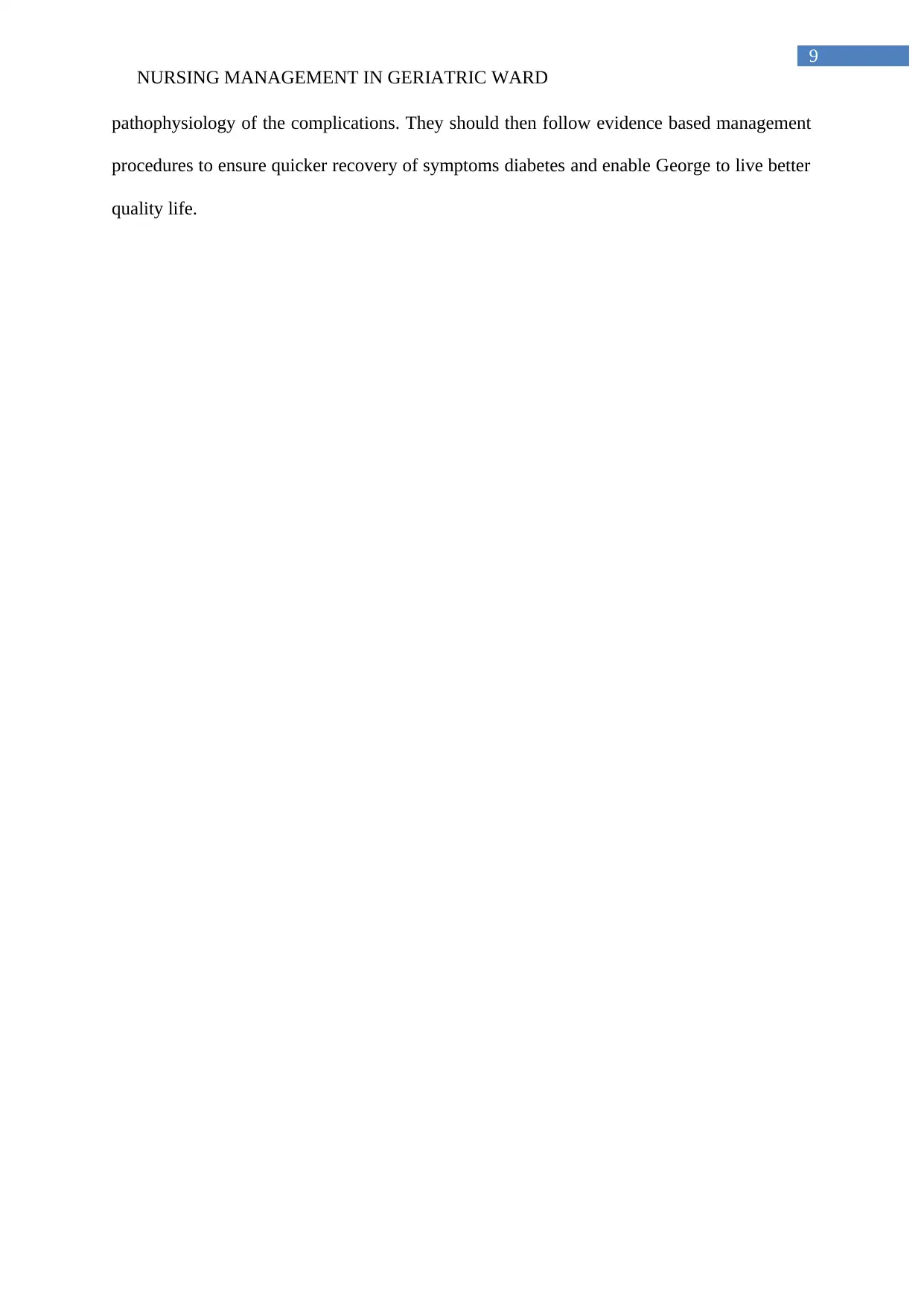
9
NURSING MANAGEMENT IN GERIATRIC WARD
pathophysiology of the complications. They should then follow evidence based management
procedures to ensure quicker recovery of symptoms diabetes and enable George to live better
quality life.
NURSING MANAGEMENT IN GERIATRIC WARD
pathophysiology of the complications. They should then follow evidence based management
procedures to ensure quicker recovery of symptoms diabetes and enable George to live better
quality life.
Paraphrase This Document
Need a fresh take? Get an instant paraphrase of this document with our AI Paraphraser
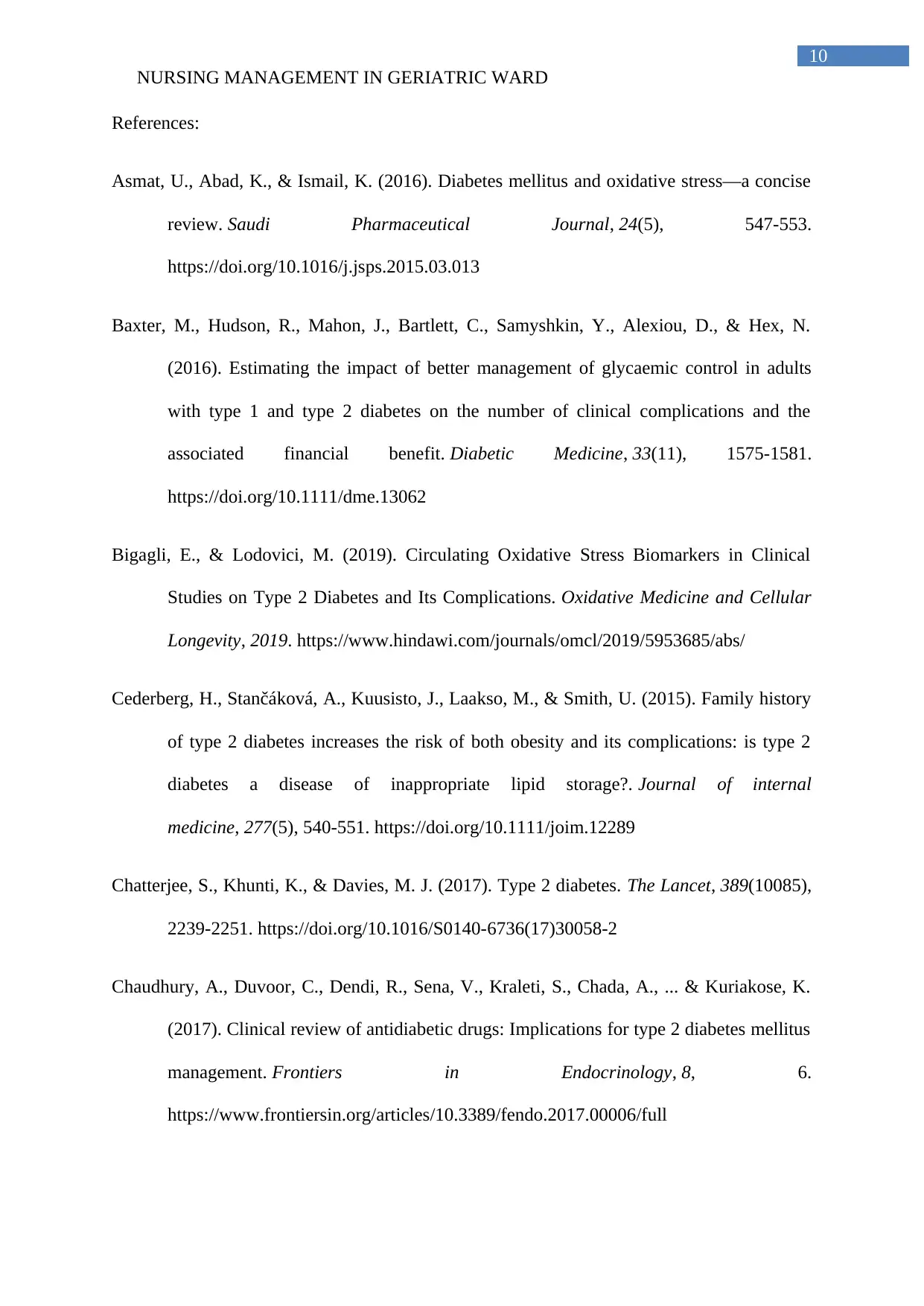
10
NURSING MANAGEMENT IN GERIATRIC WARD
References:
Asmat, U., Abad, K., & Ismail, K. (2016). Diabetes mellitus and oxidative stress—a concise
review. Saudi Pharmaceutical Journal, 24(5), 547-553.
https://doi.org/10.1016/j.jsps.2015.03.013
Baxter, M., Hudson, R., Mahon, J., Bartlett, C., Samyshkin, Y., Alexiou, D., & Hex, N.
(2016). Estimating the impact of better management of glycaemic control in adults
with type 1 and type 2 diabetes on the number of clinical complications and the
associated financial benefit. Diabetic Medicine, 33(11), 1575-1581.
https://doi.org/10.1111/dme.13062
Bigagli, E., & Lodovici, M. (2019). Circulating Oxidative Stress Biomarkers in Clinical
Studies on Type 2 Diabetes and Its Complications. Oxidative Medicine and Cellular
Longevity, 2019. https://www.hindawi.com/journals/omcl/2019/5953685/abs/
Cederberg, H., Stančáková, A., Kuusisto, J., Laakso, M., & Smith, U. (2015). Family history
of type 2 diabetes increases the risk of both obesity and its complications: is type 2
diabetes a disease of inappropriate lipid storage?. Journal of internal
medicine, 277(5), 540-551. https://doi.org/10.1111/joim.12289
Chatterjee, S., Khunti, K., & Davies, M. J. (2017). Type 2 diabetes. The Lancet, 389(10085),
2239-2251. https://doi.org/10.1016/S0140-6736(17)30058-2
Chaudhury, A., Duvoor, C., Dendi, R., Sena, V., Kraleti, S., Chada, A., ... & Kuriakose, K.
(2017). Clinical review of antidiabetic drugs: Implications for type 2 diabetes mellitus
management. Frontiers in Endocrinology, 8, 6.
https://www.frontiersin.org/articles/10.3389/fendo.2017.00006/full
NURSING MANAGEMENT IN GERIATRIC WARD
References:
Asmat, U., Abad, K., & Ismail, K. (2016). Diabetes mellitus and oxidative stress—a concise
review. Saudi Pharmaceutical Journal, 24(5), 547-553.
https://doi.org/10.1016/j.jsps.2015.03.013
Baxter, M., Hudson, R., Mahon, J., Bartlett, C., Samyshkin, Y., Alexiou, D., & Hex, N.
(2016). Estimating the impact of better management of glycaemic control in adults
with type 1 and type 2 diabetes on the number of clinical complications and the
associated financial benefit. Diabetic Medicine, 33(11), 1575-1581.
https://doi.org/10.1111/dme.13062
Bigagli, E., & Lodovici, M. (2019). Circulating Oxidative Stress Biomarkers in Clinical
Studies on Type 2 Diabetes and Its Complications. Oxidative Medicine and Cellular
Longevity, 2019. https://www.hindawi.com/journals/omcl/2019/5953685/abs/
Cederberg, H., Stančáková, A., Kuusisto, J., Laakso, M., & Smith, U. (2015). Family history
of type 2 diabetes increases the risk of both obesity and its complications: is type 2
diabetes a disease of inappropriate lipid storage?. Journal of internal
medicine, 277(5), 540-551. https://doi.org/10.1111/joim.12289
Chatterjee, S., Khunti, K., & Davies, M. J. (2017). Type 2 diabetes. The Lancet, 389(10085),
2239-2251. https://doi.org/10.1016/S0140-6736(17)30058-2
Chaudhury, A., Duvoor, C., Dendi, R., Sena, V., Kraleti, S., Chada, A., ... & Kuriakose, K.
(2017). Clinical review of antidiabetic drugs: Implications for type 2 diabetes mellitus
management. Frontiers in Endocrinology, 8, 6.
https://www.frontiersin.org/articles/10.3389/fendo.2017.00006/full
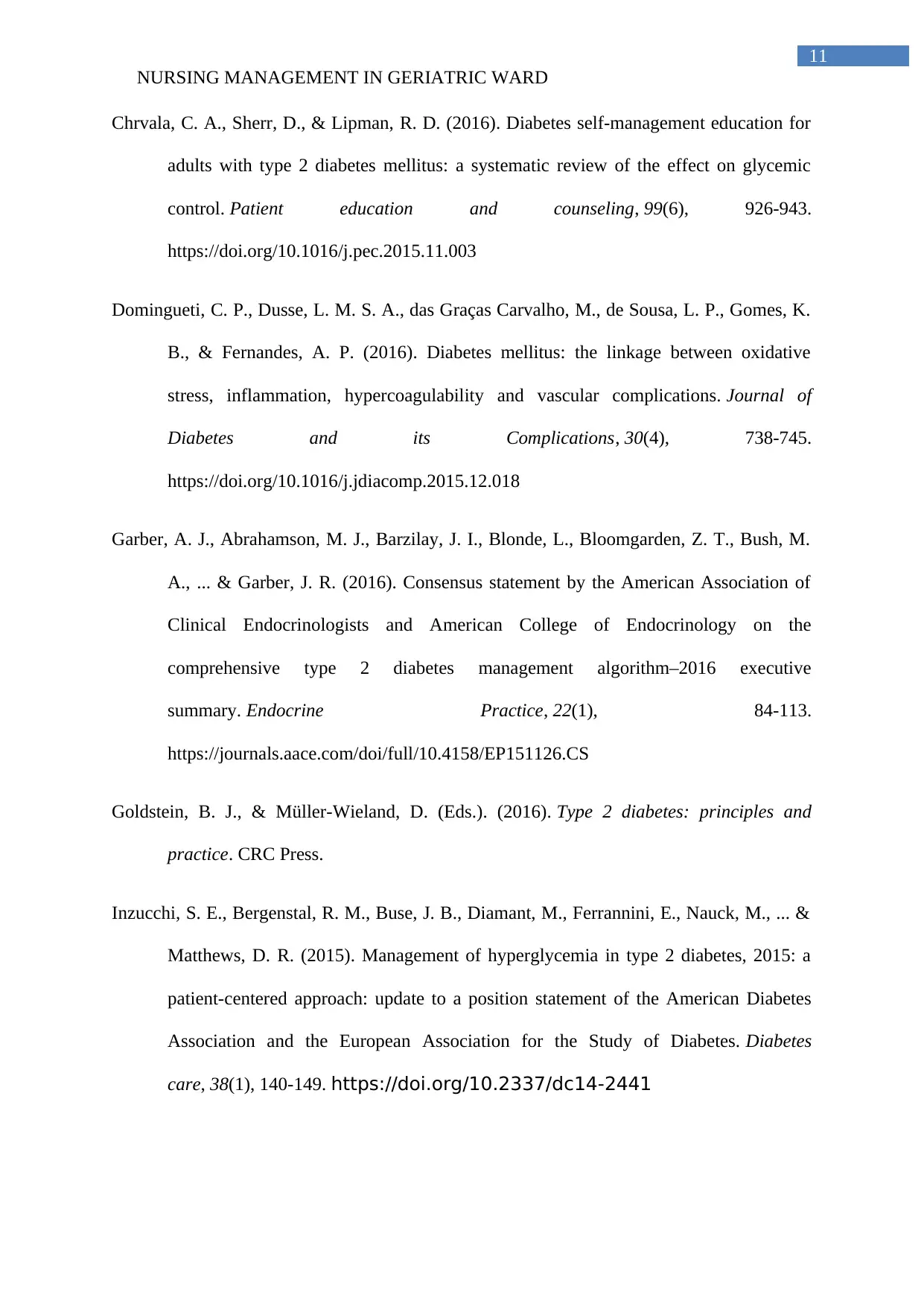
11
NURSING MANAGEMENT IN GERIATRIC WARD
Chrvala, C. A., Sherr, D., & Lipman, R. D. (2016). Diabetes self-management education for
adults with type 2 diabetes mellitus: a systematic review of the effect on glycemic
control. Patient education and counseling, 99(6), 926-943.
https://doi.org/10.1016/j.pec.2015.11.003
Domingueti, C. P., Dusse, L. M. S. A., das Graças Carvalho, M., de Sousa, L. P., Gomes, K.
B., & Fernandes, A. P. (2016). Diabetes mellitus: the linkage between oxidative
stress, inflammation, hypercoagulability and vascular complications. Journal of
Diabetes and its Complications, 30(4), 738-745.
https://doi.org/10.1016/j.jdiacomp.2015.12.018
Garber, A. J., Abrahamson, M. J., Barzilay, J. I., Blonde, L., Bloomgarden, Z. T., Bush, M.
A., ... & Garber, J. R. (2016). Consensus statement by the American Association of
Clinical Endocrinologists and American College of Endocrinology on the
comprehensive type 2 diabetes management algorithm–2016 executive
summary. Endocrine Practice, 22(1), 84-113.
https://journals.aace.com/doi/full/10.4158/EP151126.CS
Goldstein, B. J., & Müller-Wieland, D. (Eds.). (2016). Type 2 diabetes: principles and
practice. CRC Press.
Inzucchi, S. E., Bergenstal, R. M., Buse, J. B., Diamant, M., Ferrannini, E., Nauck, M., ... &
Matthews, D. R. (2015). Management of hyperglycemia in type 2 diabetes, 2015: a
patient-centered approach: update to a position statement of the American Diabetes
Association and the European Association for the Study of Diabetes. Diabetes
care, 38(1), 140-149. https://doi.org/10.2337/dc14-2441
NURSING MANAGEMENT IN GERIATRIC WARD
Chrvala, C. A., Sherr, D., & Lipman, R. D. (2016). Diabetes self-management education for
adults with type 2 diabetes mellitus: a systematic review of the effect on glycemic
control. Patient education and counseling, 99(6), 926-943.
https://doi.org/10.1016/j.pec.2015.11.003
Domingueti, C. P., Dusse, L. M. S. A., das Graças Carvalho, M., de Sousa, L. P., Gomes, K.
B., & Fernandes, A. P. (2016). Diabetes mellitus: the linkage between oxidative
stress, inflammation, hypercoagulability and vascular complications. Journal of
Diabetes and its Complications, 30(4), 738-745.
https://doi.org/10.1016/j.jdiacomp.2015.12.018
Garber, A. J., Abrahamson, M. J., Barzilay, J. I., Blonde, L., Bloomgarden, Z. T., Bush, M.
A., ... & Garber, J. R. (2016). Consensus statement by the American Association of
Clinical Endocrinologists and American College of Endocrinology on the
comprehensive type 2 diabetes management algorithm–2016 executive
summary. Endocrine Practice, 22(1), 84-113.
https://journals.aace.com/doi/full/10.4158/EP151126.CS
Goldstein, B. J., & Müller-Wieland, D. (Eds.). (2016). Type 2 diabetes: principles and
practice. CRC Press.
Inzucchi, S. E., Bergenstal, R. M., Buse, J. B., Diamant, M., Ferrannini, E., Nauck, M., ... &
Matthews, D. R. (2015). Management of hyperglycemia in type 2 diabetes, 2015: a
patient-centered approach: update to a position statement of the American Diabetes
Association and the European Association for the Study of Diabetes. Diabetes
care, 38(1), 140-149. https://doi.org/10.2337/dc14-2441
⊘ This is a preview!⊘
Do you want full access?
Subscribe today to unlock all pages.

Trusted by 1+ million students worldwide
1 out of 14
Related Documents
Your All-in-One AI-Powered Toolkit for Academic Success.
+13062052269
info@desklib.com
Available 24*7 on WhatsApp / Email
![[object Object]](/_next/static/media/star-bottom.7253800d.svg)
Unlock your academic potential
Copyright © 2020–2025 A2Z Services. All Rights Reserved. Developed and managed by ZUCOL.





